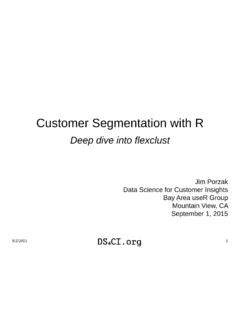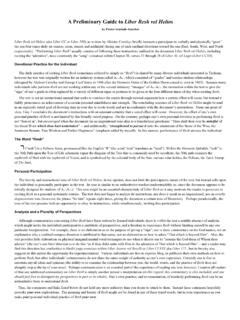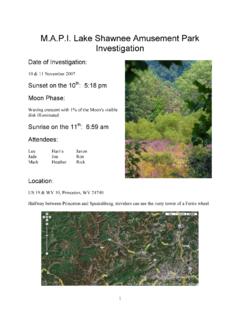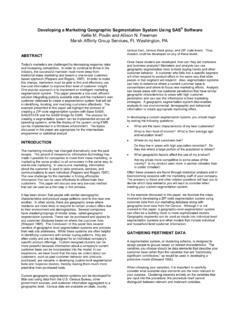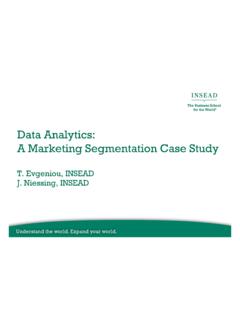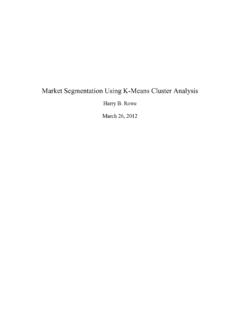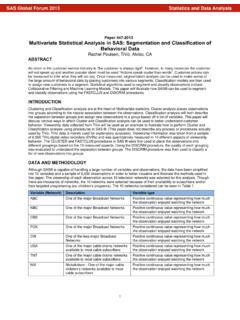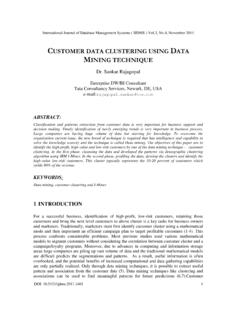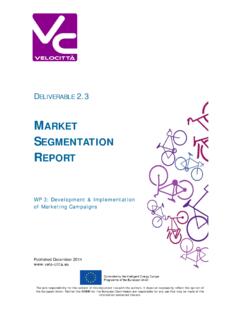Transcription of Customer Segmentation with R - Meetup
1 Customer Segmentation with R Deep dive into flexclust Jim Porzak Data Science for Customer Insights useR! 2015 Aalborg, Denmark July 1, 2015 6/24/2015 1 6/24/2015 2 Outline and how to segment? stated preference surveys. deep dive. issues of numbering and stability. best number of clusters. Appendix has references and links to learn more. Customer Segmentation Themes 6/24/2015 3 How Used? Strategic Tactical Level? General Detailed Time Constant? Long Short Impact (if correct)? 1x Huge (Small) Implementation?
2 Simple Complex 6/24/2015 4 How to Segment? Do I believe these? How can I use them? What will be impact? Many Segmentation Methods! Today s Focus: Binary choice surveys Simplest of surveys to design & take. Cluster analysis is a great tool to understand how respondents fall into natural segments Methods also apply to any binary choice behavioral data sets. For examples of other Segmentation methods see archives at 6/24/2015 5 Today s Example Data Set The volunteers data set from the flexclust package. 1415 Australian volunteers responded to the survey which had 19 preference check boxes for motivations to volunteer.
3 The question could look like: Q5. Please check all motivations that apply to you: 6/24/2015 6 example socialise career lonely active community cause faith services children benefited network recognition 6/24/2015 7 Segmenting Binary Choice Data Pick all that apply type question. Not picking is not the opposite of picking a attribute. (item checked) <> NOT (item unchecked) Totally unsupervised. We only specify the number of clusters we want. Two necessary criteria for a good solution: cluster solution is stable ~ Repeatable with different random starts segments make sense to the business - Believable story AND is actionable AND has anticipated impact.
4 6/24/2015 8 Tool we use: flexclust by Fritz Leisch Allows different distance measures In particular, the Jaccard distance which is suited for binary survey data or optional properties lists. 1 is a yes to the question - it is significant. 0 is a does not apply not opposite of yes Predict(kcca_object, newdata) to segment new customers. Additionally flexclust had very good diagnostic and visualization tools. As an R package, it leverages the rest of the R ecosystem. Simple flexclust Run (1 of 2) 6/24/2015 9 Set up input to flexclust: Set up the parameters: Invoke kcca(): k-centroid cluster analysis data("volunteers") vol_ch <- volunteers[-(1.)]
5 2)] <- (vol_ch) fc_seed <- 577 ## Why we use this seed will become clear below num_clusters <- 3 ## Simple example only three clusters (fc_seed) <- kcca( , k = num_clusters, = TRUE, control = fc_cont, family = kccaFamily(fc_family)) fc_cont <- new("flexclustControl") ## holds "hyperparameters" fc_cont@tolerance <- <- 30 fc_cont@verbose <- 1 ## verbose > 0 will show iterations fc_family <- "ejaccard" ## Jaccard distance w/ centroid means First few iterations: Results: ## 1 Changes / Distsum : 1415 / ## 2 Changes / Distsum : 138 / ## 3 Changes / Distsum : 39 / Simple flexclust Run (2 of 2) 6/24/2015 10 summary( ) ## kcca object of family 'ejaccard' ## call: ## kcca(x = , k = num_clusters, family = kccaFamily(fc_family), ## control = fc_cont, = TRUE) ## ## cluster info: ## size av_dist max_dist separation ## 1 1078 ## 2 258 ## 3 79 ## ## no convergence after 30 iterations ## sum of within cluster distances.
6 Segment Separation Plot 6/24/2015 11 Each respondent plotted against the first two principal components of data. Color is cluster assignment. Centroid of each cluster. A thin line to other centroid indicates better separation (in real problem space) Solid line encloses 50% of respondents in cluster; dotted 95%. <- prcomp( ) ## plot on first two principal components plot( , data = , project = , main = ..) Also known as neighborhood plot. Purpose: Help business partners visualize clusters and how respondents fall within cluster boundaries.
7 IOW, are clusters real ? Segment Profile Plot 6/24/2015 12 Header: segment #, Count, & % total Bar: proportion of response in cluster. Red line/dot: overall proportion Greyed out when response not important to differentiate from other clusters. BUT, can still be an important characteristic of cluster Tick-box labels barchart( , = "#", shade = TRUE, layout = c( @k, 1), main = ..) Purpose: Help business partners translate clusters into segment stories. IOW, describe the clusters in business friendly terms. 6/24/2015 13 So far: we ve used standard flexclust techniques.
8 See appendix for references and links. Now, we ll address three practical issues: starting seeds will number ~ equal clusters differently. The numbering problem. starting seeds will result in quite different clusters. The stability problem. is no automatic way to pick optimum k. The best k problem. The Numbering Problem fc_reorder {CustSegs} Reorder clusters in a kcca object. Usage: fc_reorder(x, orderby = "decending size") 6/24/2015 14 Two different seeds have nearly equal solutions, but are labeled differently: The Stability Problem 6/24/2015 15 Three different seeds have quite different solutions: We need a simple way to classify each solution just use sizes of two biggest clusters: Simple Method to Explore Stability For a given k, run a few hundred solutions (incrementing seed each time): Re-order clusters in descending size order Save.
9 K, seed, cluster #, & count Call Size_1 the count for 1st cluster; Size_2 the count for 2nd cluster. Scatter plot w/ 2D density curves: Size_2 x Size_1 Solve for peak location 6/24/2015 16 Stability Plot of kcca Solutions for k=3 6/24/2015 17 fc_rclust {CustSegs} Generate a List of Random kcca Objects. Usage: fc_rclust(x, k, fc_cont, nrep = 100, fc_family, verbose = FALSE, FUN = kcca, seed = 1234, plotme = TRUE) The Best k Problem 6/24/2015 18 K=8 is smallest k with single peak is best stable solution.
10 We must also validate segment stories are the best. Generate stability plots for k = 2, 3, .., 10: Segment Separation for best k = 8 (seed = 1333) 6/24/2015 19 Profile Plot for best k = 8 (seed = 1333) 6/24/2015 20 What We Covered Customer Segmentation background. Deep dive into using flexclust on binary choice type data Example kcca() run The numbering problem. The stability problem Provisional rule-of-thumb that best k is min(k, for single peak contours) Next Steps Get typical respondent(s) closest to each centroid.
